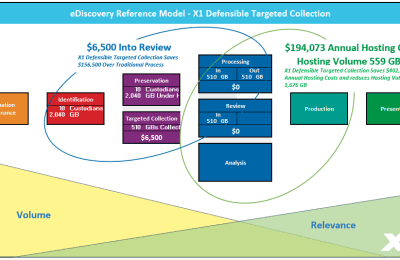By John Patzakis and Chas Meier
eDiscovery can be an expensive and time-consuming process when traditional data collection methods are employed. With legacy processes, it can take weeks for electronically stored information (ESI) collections to finally end up in review. Time is money, and utilizing dated processes can dramatically increase costs as well as risk. One of the biggest drivers of excessive eDiscovery costs is over-collection of irrelevant or unnecessary information. This in turn leads to a larger amount of data entering the processing and initial review funnel.
In fact, old school manual collection efforts require employing multiple tools, data copies, and manual steps into your litigation workflow. The majority of ESI processing consists of data culling and filtering, deduplication, text extraction, metadata preservation, and then staging the data for upload into a review platform, often in the form of a load (DAT) file. Some ESI processing solutions require deployment of non-integrated on-premise hardware appliances that further increase costs and add time delays. Manual collections, multiple generations of data duplication, and disjointed handoffs exponentially increase costs and risk while significantly delaying documents being available for review.
If you are still using stand-alone processing tools, you are doing it wrong and subjecting your clients to extensive costs and time delays. Modern collection technologies combine targeted collection with in-place processing of data which is automatically collected, processed, and uploaded into a review platform such as Relativity in one fell swoop.
The graph below established that the cost for collection, processing and first month hosting under a traditional preservation process can be upwards of $12,000 per custodian:

Properly targeted preservation initiatives are favored by the courts for purposes of civil eDiscovery and enabled by next generation software to search data sources quickly and effectively in-place throughout the enterprise. The value of targeted and proportional preservation is recognized in the Committee Notes to the recent FRCP amendments, which urge the parties to reach agreement on the preservation of data, keywords, and other metadata to identify responsive materials. See also, In re Genetically Modified Rice Litigation,
“Preservation efforts can become unduly burdensome and unreasonably costly unless those efforts are targeted to those documents reasonably likely to be relevant or lead to the discovery of relevant evidence.”
X1 Enterprise Platform significantly streamlines the eDiscovery workflow with integrated culling and deduplication, thereby eliminating the need for expensive and cumbersome ESI processing tools. That way, the ESI can be populated straight into Relativity from an X1 collection without multiple hand offs, extensive project management and inefficient data processing.
The ability to directly and transparently collect data from custodian laptops, desktops, Microsoft 365 and other cloud sources into a RelativityOne / Relativity workspace is a game-changer that enables Attorney’s to begin review in hours rather than weeks.
The second chart shows how this streamlined approach, based upon a detailed ROI analysis, reduces eDiscovery costs by over 90 percent:

So, in terms of the big picture, X1 Enterprise provides a complete platform to implement a properly targeted preservation strategy in the enterprise enabling organizations to save a lot of time, save a lot of money, and be able to make faster and better decisions.
When you accelerate the speed to review and eliminate over-collection and inefficient processing, you gain much better early insight into your data and can increase efficiencies on many levels.
Finally, the calculations represented in the charts were generated from a customizable ROI cost calculator created by Chas Meier, based upon his more than 20 years’ experience in eDiscovery service provider roles. If you would like a copy of this ROI calculator, please contact Chas at CMeier@x1.com.